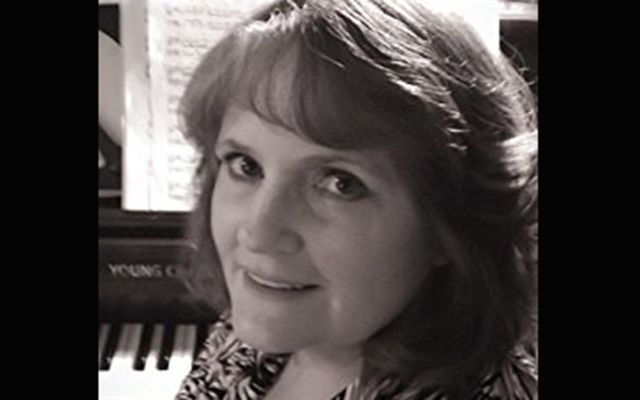150 years ago there was no International Women’s Day. There wasn’t even a vote for women. So what chance for a poor illiterate, indigent Irish woman facing a murder trial before an all-male jury in New Jersey?
What chance then, what chance now?
The case of Bridget Deignan (sometimes written as Durgan) was once open and shut.
Author Sheila Duane opened it again.
Now it is about to be opened and shut a second time by a TV show.
With the same result as before.
Bridget would begin her short life in Sligo.
That life would be ended at the end of a hangman’s rope in New Brunswick, New Jersey, on August 30, 1867.
According to Sheila Duane, author of “Bridget’s Hanging,” Bridget was executed for a crime she did not commit, and by citizens who despised the Irish, the impoverished, and feared and distrusted Catholics.
That hanging is soon to be recreated on a TV show, one in a series, “Deadly Women,” which runs on the Investigation Discovery channel.
“Deadly Women,” is now in its eleventh season, so it is clearly well established on the small screen with a significant viewership.
It also runs in Spanish and Italian language versions.
Viewers are to be treated to Bridget’s story, or at least the official version of that story which Duane refutes in her book.
Some weeks ago, Duane was contacted by the show, which is produced in Australia.
Sheila Duane was an obvious contact. She was the expert. She had written the book.
So when contacted she told the “Deadly Women” producer that Bridget was the victim of anti-Irish, anti-Catholic prejudice, and was, in fact, innocent of the charge of murder.
As Sheila wrote in the Irish Echo just a while back: “I fell upon the story of Bridget’s short, tragic life while reading a book called ‘Women Who Kill,’ by Ann Jones.
“Jones wrote about Bridget Deignan, accepting that she may have been guilty, but also convinced she’d been railroaded by a judicial system driven by a sense of superiority, a hatred of “Romanism” (Catholicism), and unrelenting greed.
“Facts also indicate that the judiciary in 1867 New Brunswick was discriminatory, unsympathetic, and incompetent.
“Greed was a major factor in the way the trial and the defense were conducted, and the media’s reporting on the case.

Bridget's Hanging by Sheila Duane.
“Bridget’s own defense attorney, Mr. Garnett Adrian, also offered for sale a copy of his version of Bridget’s confession, although Mr. Adrian at least had the decency to wait until after Bridget was hanged to do so.
“A New York Times correspondent was quick to point out that all of these confessions were wildly different.
“Further, several other confessions published as murder pamphlets, a popular read at the time, were published after Bridget’s execution, including one by a “Rev. Mr. Brendan” (Rev., in this case, being a self-imposed term of honor, not religious leadership).
“Research indicates he either never met her (Bridget) or may have briefly spoken with her once.
“Barclay & Company Publishers of Philadelphia published at least one other murder pamphlet, but it was printed without an author’s name.
“Regardless, Bridget was not a killer.
“Instead, she was guilty of being a poor, illiterate, Irish Catholic, immigrant, all of which were loathed in nineteenth-century America.
“Tried by a media, not unlike today’s, and condemned by mob mentality, Bridget and her sensationalized story eclipsed the murder victim herself – Mary Coriell, for whom Bridget worked as a domestic – and a more likely suspect.
“While journalists at the time painted a picture of Bridget as monstrous, my book, 'Bridget’s Hanging,' looks with fresh eyes at a character who was intellectually childlike, who practiced a foreign religion, believed in unfamiliar superstitions, and who spoke with a brogue that was difficult for Americans to understand.
“The book dissects the case against Bridget Deignan/Durgan and finds it wholly unconvincing. I’ve tried, through primary and secondary research, to find a little justice for Bridget at last.
“My research indicated that she had been railroaded by a judicial system driven by a sense of superiority, a loathing of the indigent, a hatred of 'Romanism' (Catholicism), and negligence of constitutional law.”
Sheila Duane’s assertion that she had uncovered the real killer would make for a fascinating TV show – “author uncovers real truth behind long ago murder!”
You would think.
Continues Sheila Duane: “In 1867, most people in New Jersey and the surrounding states believed that Bridget was a brute, little more than an animal, who had willfully and violently murdered her employer for financial and personal gain.
“People believed this because that’s what the newspapers printed – newspapers that sold more copies when the printed stories were more salacious, more agitating, more extraordinary.
“And Bridget’s particular saga had all the makings of good crime drama: a lovely, sympathetic victim, Mrs. Mary Ellen Coriell, a genteel doctor’s wife and the mother of a beautiful daughter named Mamey; a wicked, ignorant, immigrant housemaid and former prostitute, who from jealousy and evil intent committed premeditated murder for bloodlust and self-gratification; and an arson fire that scorched the baby-fine hair of the murdered woman’s daughter, set by the villainous, Irish immigrant to destroy murderous evidence.
“A good story to be sure.
“But there is another version of this tragedy in the subtext of the many newspaper articles and the multiple confessions that were marketed within hours of Bridget’s death on the gallows.
“Was Bridget Deignan a murderer, or a victim of economic and cultural prejudice?
“Any close reading of the documents and newspaper articles related to Bridget’s case demonstrates that conclusive evidence was lacking, testimony was confused at best, perjury is certain in more than one case, and the motives of so many individuals involved were dubious, or worse.
“The false confessions contain factual errors that prove their speciousness, the first of which is Bridget’s own name: Durgan.
“Her name was in fact Bridget Deignan. She insisted on this to the New York Times reporter who spoke with her after her conviction.
“It was, she stressed, “her Irish brogue that confused her last name to the residents of New Jersey and the reporters from New York and Philadelphia.
“The ‘confessions’ also describe Bridget as a young woman who grew up in a relatively well-to-do family in Ireland, and as a former prostitute and grifter whose purpose was to obtain money and status by any means possible, even murder.
“Research has proven that this is not the case.
“Although Bridget was born in Sligo in 1844, as was written in newspaper articles, and in the sham confessions marketed throughout the United States, she was not born to a well-to-do family.
“In fact, she had spent the earliest years of her life in dire poverty, living near starvation on farmland infected by the potato fungus.
“By the age of ten, she was helping her father unload barges along Killala Bay, living as a gypsy, eating cabbage, and sleeping in barns or warehouses.
“Finally, after her father’s lungs began to fail, the family sought refuge at Union Poor Law workhouses in Sligo and Boyle, County Roscommon.
“Ultimately, they were admitted to the workhouse at Carrick-on-Shannon in County Leitrim where she watched her family waste away from lung, bone, and joint tuberculosis.
“Bridget’s mother, sister, and two brothers died of tuberculosis in 1865 in Carrick-on-Shannon.
They were buried in unmarked graves in the long furrows of loose earth behind the workhouse infirmary.
“Bridget had been well enough to watch as her brother, James, was buried with two other children.
“After her brother Luke, sixteen and living in the men’s section of the workhouse with his father, died and was buried, Patrick Deignan told his only surviving child, Bridget, that it was time for them to leave.
“He wanted to go back to Sligo before he died.
“There was a Union Poor Law workhouse in Sligo that had been too crowded to admit Patrick and his family a few years earlier, but he was convinced that he should die in Sligo, perhaps in that workhouse.
Bridget and her father left Carrick-on-Shannon in late March of 1866 on foot.
“Because workhouses were refuges for widows and children,” said Duane, “there was no place for Bridget in the Sligo workhouse, as their women’s accommodations were over maximum capacity.
“Sligo had some ‘poor rate’ emigration funds available, and her father convinced the guardians to pay Bridget’s fare to Liverpool, and from there to America.
“Bridget didn’t want to leave her father, but he convinced her that America would be like the Isle of the Blest from childhood stories of Irish mythology, a perfect place where it was always summer and life was forever easy; where enchanted animals lived idyllic lives, handfed by the noble girls and boys who found their way to such a piece of heaven.
“For someone like Bridget Deignan, who was leaving a country that not only failed her economically and medically, but also spiritually, the ‘Isle of the Blest’ magical thinking that prompted her to board a ship to New York City also promised her that she would not be hanged in August of 1867.
“Within hours of her employer’s murder, multiple newspapers published Bridget’s ‘confession’ and described her as an immigrant ‘fiend’ and a ‘wild beast,’ portrayals that increased newspaper sales and interest in the case.”
And all of this occurred, according to Sheila Duane, while the real murderer escaped justice and left the state.
“I was moved to write Bridget’s story for several reasons: first, my own ancestors came from Ireland and faced the same kind of prejudice that Bridget and others like her faced.
“As I researched her story, I had to ask myself, what could she possibly have done to save herself?
“Bridget was guilty of being a poor, illiterate, Catholic, and an Irish immigrant. She was a victim of anti-Catholic, anti-immigrant, misogynistic yellow journalism.
“She was, however, not guilty of murder.
“Her death on the gallows in New Jersey in 1867 was a gruesome miscarriage of justice.”
When first contact by “Deadly Women,” Duane was asked to write up an evaluation of the evidence against Bridget.
She was also asked to review the unconstitutional aspects of Bridget’s trial.
“I submitted a relatively long research/factual document which, I believe, proves that at the very least Bridget did not receive a fair trial. I also illustrated Bridget's physical inability to have committed the crime.”
Duane heard nothing for a few weeks.
She followed up only to receive an email stating that the producer she had been liaising with no longer worked for the program.
Her input to the show had been reviewed, but the program would be sticking to the script – as written a century and a half ago.
That script required a deadly woman named Bridget who had committed murder most foul.
“The program will be produced from the perspective of Bridget as the murderer,” said Duane. “Apparently, ‘Irish Immigrant as Mad Dog Killer’ makes a better story than ‘anti-Irish, anti-Catholic prejudice convicts immigrant.’"
Sheila Duane had spent three years researching her book and the result was a declaration of Bridget’s innocence.
“I felt foolish for believing that the truth mattered,” she said.
“Deadly Women” – a series which first aired in 2005 – only wanted Duane to appear on the show if she described Bridget as the killer.
“The publicity for my book would have been great, but there's the truth and apparently then there's television.
“It's my honest feeling that Bridget was convicted and hanged because the ‘Mad Dog Irish Maid’ story sold more papers than a story about a woman killed during an attempted robbery.”
Some things change, some don’t.
And Bridget Diegnan’s spirit is staring at the shadow of the hangman’s rope.
---
This story was originally published in the Irish Echo. You can read more from them here.




Comments